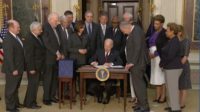As transportation leaders from states look ahead to a new administration, an adviser to President-elect Joe Biden is encouraging them to expand their internal lists of priority projects, identifying some that can get started quickly for a rapid economic boost and others that will have long-range “transformative” impacts on their states.
Former Deputy U.S. Dept. of Transportation Secretary John D. Porcari told attendees of the American Association of State Highway and Transportation Officials (AASHTO) annual meeting on Nov. 12 that the Biden administration is likely to seek an increase in funding for current programs.

Porcari said the plan would likely include added funds for existing core federal programs with funds distributed by formula.
He said there also would be a focus on existing grant programs that DOT awards via competitions. The longest-running such program is for TIGER grants, which the Trump administration renamed BUILD grants.
Porcari said the new administration would have "a TIGER on steroids," with more funding. "I think you need to kind of flood the zone with more [dollars] on the formula side, more on the competitive-grant side," he said.
Shovel-ready, but also 'shovel-worthy'
In remarks to officials at the event, held virtually, Porcari said one overall goal will be advancing “not just shovel-ready projects but shovel-worthy projects—the ones that are actually worth doing even if they’re not the ones that are the easiest to get off the ground.”
Porcari is a former secretary of the Maryland DOT and recently spent more than six years as a top manager at engineering firm WSP, holding the post of president of the firm's U.S. Advisory Services unit. He left WSP in July to be the Biden campaign transportation adviser.
But Porcari noted that his comments did not represent the views of the President-elect, but reflected the adviser's own thoughts “on where we’re likely to be going” in transportation policy.
Porcari was upbeat about the outlook for a major transportation investment push, possibly starting early in 2021. “There are real prospects for a bipartisan, broad infrastructure program,” he said. “It’s no secret to anybody that President-elect Biden has long been an advocate of infrastructure. He feels it in his bones….You certainly have a willing partner in the President-elect.“
Porcari recalled Biden’s role in implementing the 2009 American Recovery and Reinvestment Act,” when President Obama put him in charge of overseeing the various programs and flow of funds from the massive $840-billion package. Porcari played a key role in overseeing U.S. DOT's share of the recovery act program.
Biden“dove into details and really pushed to keep accelerating the work that was out there," said Porcari.
Two-part program
Porcari expects the Biden administration to pursue a two-step approach in transportation initiatives. The first step, he said, “is to get the transportation system and the economy in general, back on its feet.”
That is likely to involve additional measures to protect the health of the traveling public and transportation system workers. In particular, he said, a health-related focus in transit and aviation is “a going to be a key early effort.” It was unclear whether that would come through legislation or executive action.
The second step would center on funding and require legislation. That could take the form of a new surface-transportation bill—a successor to the current one-year authorization is due by Sept. 30. Another option is a broader stimulus measure.
Focus on resilience
Several themes will thread through the programs. "Climate change and resilience will be a central element," Porcari said. That would include supporting projects that include features to withstand storms and other natural disasters. Porcari said, "You can expect [resilience] basically to trickle through the federal program across the board."
Another theme will involve technology, with administration officials allowing states to pursue their own ideas for innovative systems but having some federal coordination to avoid 50 states going 50 different ways, something that Porcari noted would be problematic for equipment manufacturers and systems providers.
Technology would play a role in another theme, improving safety, with one focus being an attempt to reduce the motor vehicle fatality rate, he said.
Many of Porcari's comments applied to highways and bridges, by far the largest sector in terms of federal and state dollars.
Transit, Passenger rail
But Porcari did cite transit, saying the administration will ensure systems serving area with populations of 100,000 and more "are built, enhanced, rebalanced as appropriate."
The transit effort, however, wouldn't be confined to urban areas. He said the incoming administration is likely to make sure that transit would be "a viable part" of transportation systems throughout the country,
Biden has long been a fan of Amtrak, and unsurprisingly, Porcari said passenger rail would be part of the infrastructure plan. He said that with airlines withdrawing from certain routes, passenger rail could be a "viable substitute" in pairs of cities 400 to 500 miles apart.
Jim Tymon, AASHTO executive director, said focusing on passenger rail in corridors of several hundred miles is "a doable goal and in relatively short order, at least from an infrastructure standpoint."
Overall, Tymon said of Porcari's remarks, "I think there's a lot here for state DOTs to be excited about."






Post a comment to this article
Report Abusive Comment